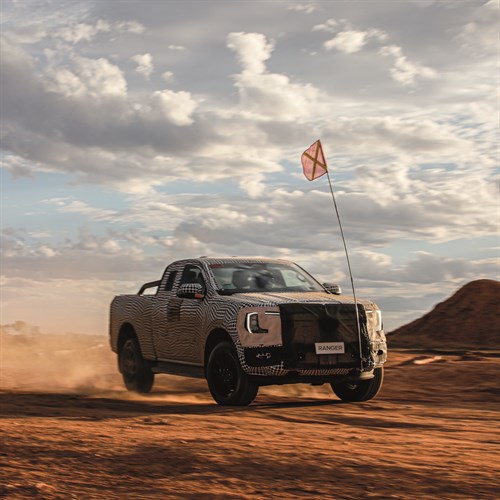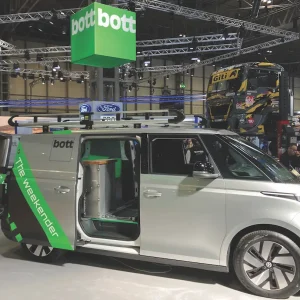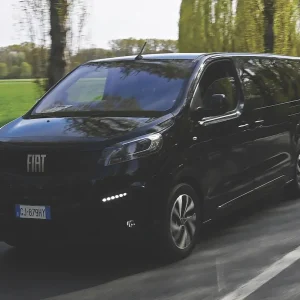It’s hard not to notice the distinctive LEVC VN5, the range-extender hybrid van based on a London taxi that is built in Coventry.
While the company can claim to date back to 1908, when taxicab dealers Mann and Overton created a special taxi cab designed to meet the condition of fitness requirements for London vehicles, the modern London Electric Vehicle Company (LEVC) evolved into existence in 2017, after a takeover by Chinese firm Geely in 2013 saw its direction shift towards alternative fuelled vehicles. It’s fair to say that under Chinese ownership the company has prospered, with more than £500m poured into products and a new headquarters in Antsy, Coventry.
“Being part of the Geely group is very beneficial to LEVC, both in terms of investment and shared technologies” Richard Hudson, LEVC commercial director says. The brand has seen a rapid expansion and a significant rise in its profile, not least from the somewhat surprising introduction of a van model, based entirely on that stalwart of the London transport scene, the TX taxi. While the taxi might be an almost uniquely British phenomenon, the VN5 has launched in Germany, Austria, Poland, Hungary, Spain and the Netherlands, with more still to come.
“One of LEVC’s goals is to move from the current 90% domestic sales to 60% export in 2024. To achieve this, our focus is on network development and entering key European markets. In Germany, for example, we already have 12 full dealer partners and two aftersales partners. In total there are around 23 dealer partners across various European markets and LEVC’s goal is to almost double this by the end of the year,” explains Hudson.
“We also have importers in rest of world markets like Egypt and Japan and we are in active discussions with other interested parties in various other markets,” he adds.
That’s formidable expansion for a company, which prior to July last year was only known for its taxis, but it was never its intention to stand alone, according to Hudson.
“LEVC has always planned to produce more than just the TX, with VN5 being a natural progression and ideal product to enter into the 1.0t
van market. It utilises many of the same features as TX, such as the bonded aluminium monocoque body structure and eCity range-extended electric powertrain.”
The shift away from taxi production is, in fact, quite dramatic, with the VN5 expected to account for around 70% of LEVC’s volume, including in it’s European markets, which are expected to play a key role in facilitating this significant growth.
“The taxi will always be part of our core product offering, but of course the market and volume opportunity is far greater with vans. We are working with various different partners, such as Royal Mail, BT group, DPD and more as part of an initial trial process. Dealers are also receiving interest from smaller fleets and business owners that want to be more sustainable in their operations. VN5 is aimed at anyone who wants to utilise an electric vehicle without the range-anxiety.”
The rapid growth has come about through not only investment from Geely but also a strong portfolio of shared parts and technological knowhow from the group, which includes Volvo cars and electric off-shoot Polestar. The VN5 shares much of the same technological characteristics as the TX, but Hudson says it was still treated as a purpose-built vehicle requiring an extensive testing programme of its own. In total the VN5 vehicles completed the equivalent of 850,000km of testing and were engineered from the ground up to meet the tough demands of life as a commercial vehicle with the suspension tweaked and then tested to ensure that it could meet the 830kg payload allowance. The VN5 also has a longer wheelbase of 3,386mm but maintains the famous taxi turning circle of just 10.1m.

“LEVC’s vehicles have always been built to stand the test of time, and VN5 is no different. VN5 is purpose built as a light commercial van and utilises the same bonded aluminium structure as TX,” Hudson says.
“Using technology proven in the aerospace and motorsport industries, we introduced a bonded, anodised aluminium body structure – a first for the commercial vehicle sector. This design helps unlock a new level of operator benefits in terms of durability, weight, lifespan, and also includes the total cost of ownership.”
With a starting price of £46,500 the argument for total cost of ownership can sometimes be a difficult one when a similarly-sized conventional diesel van is half the cost, but Hudson is adamant the VN5 can compete and make a compelling case for all customers.
“VN5 is built to last for 15 years plus, which is far longer than a typical conventional ICE van. If you compare it to an ICE van competitor, the operating costs are much lower because of the significant fuel savings. If you compare it to a pure BEV and a customer’s daily operating mileage exceeds that vehicle’s range, you have to factor in the additional downtime costs (or lost revenue as a business) every time that vehicle is parked up to be charged. With our VN5 using 100% electric, supported with a range extender, there is no downtime.”
“In addition to TCO, the huge reduction in tonnes of CO2 output over a vehicle’s lifetime is rightly becoming more important for our customers and their businesses’ reputations. With VN5, customers can expect the vehicle to always be ready for work, offering maximum flexibility through its eCity range-extended powertrain. It offers zero-emission capability, minimal downtime and zero range-anxiety, a compelling offering in today’s market,” Hudson adds.
Educating potential customers to the benefits of a range extender over a plug-in hybrid or full battery electric vehicle might well be the hardest part of the VN5’s job but Hudson is keen to point out what he sees as the highlights, explain that it offers “the best combination of electric drive, lower emissions and cost savings
but without the range anxiety of a pure BEV”.
The VN5, however, has not been short of admirers since its launch, with Hudson describing it as having received a “bow wave of good interest” that has helped identify new customers largely amongst SMEs. Further interest has been created by the unveiling of a smart-looking campervan concept that LEVC says will likely make production by 2022.
“We’d be wrong not to look at different markets and different technologies,” Hudson explains. “What we’ve done now is relevant for maybe the next four or five years with a hybrid. Of course, we’ll be looking at pure BEVs when the time is right, but we have the right technology for today. Also, as regulation changes and EV technology develops LEVC plans to offer pure electric vehicles in the future. LEVC always planned to produce more than just TX. The VN5 is the first step in diversifying our product offering and there are many more projects in the pipeline. The one tonne van market is also extremely diverse with many customer requirements, so to serve those markets, we are working with authorised converters who can tailor our VN5 with customer-specific conversions.”
With a taxi, a van and now a camper, it’s clear there’s serious intent by LEVC to establish itself on the fringes of new sectors but with the might of Geely behind it. And with the IP from established brands like Volvo and rising-stars like Polestar there’s little doubting that one of Coventry’s oldest, but also newest, names will continue to see its stock rise – where it goes next is anyone’s guess.
Ford Ranger flexes its muscles

Pick-up trucks epitomise machismo, don’t they? Well, Ford certainly seems to think so judging by the teaser video for the new Ford Ranger, due out next year.
Tag lines like: Make sure everything works when it’s full of mud; Punishing the powertrain in the desert; Torture testing when the going gets tough; Testing the slip and grip in the freezing cold. All of which paint a picture of a hard-hitting, all-weather fighter truck, desperately trying to ape the looks of the US powerhouse Ford F-150.
This first camouflaged picture gives little away, but if all the power sliding and gratuitous gravel shots in the video – shot during the new truck’s testing regime in Australia and New Zealand – live up to the hype then the new Ranger, which will also be the basis for the next Volkswagen Amarok, will be a very exciting prospect indeed.
George Barrow is the UK judge for the International Van of the Year, the prestigious prize awarded by leading European LCV journalists.
Sponsored by:






